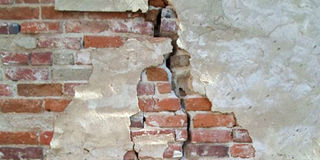Stop those cracks in your brickwork

What you need to know:
- Bricks are one of the most used materials in the construction and housing industry. However, using bricks can be a little tricky and confusing because sometimes they develop cracks. This is the reason there are expansion joints which are essential in preventing or minimising cracks. There are other ways to prevent bricks from developing cracks as Beatrice Nakibuuka explores.
No one wants to see cracks in their house. According to Francis Munyambabazi, a structural engineer at Goldenleaf Properties, these can be caused by the elements acting on flaws within the brick, but they can also be caused by a shift in the building’s weight.
Ultimately once your home starts developing cracks, there is only so much you can do without incurring a lot of expenses. Better to spend time on prevention, and be aware whether the home you are about to fall in love with may be more susceptible than others to shifting.
Bricks expansion joint
With changes in temperature, the bricks, like other construction materials will change in volume. This will depend on the brick’s location and the conditions being exerted upon it; also increase in size due to expansion by moisture and the absorption of water.
Munyambabazi says, “Employing an engineer will help because he will be able to calculate how much it will expand following some basic calculations and studying the behaviour of the materials acting upon it.”
The expansion joints in the brickwork separate bricks into small segments, in which case, each segment will act individually from other. These, therefore, reduce brick cracking by changes in temperature, moisture, either horizontally or vertically.
He, however, says the location of the joints must be at the right location. “The joints should not be in one line until the finishing of the building. They should be in a staggered pattern to enable the expansion of the bricks. It is important to make sure that the expansion joint materials run through the full thickness of the wythe.”
Right mixture
Concrete expands and shrinks with changes in moisture and temperature. The overall tendency is to shrink, and this can cause cracking at an early stage of the concrete. It is, therefore, important that you make the right mixture to make your mortar (sand and cement mixture) while you are making the bricks.
“The quantity of water used in the mortar mix can cause shrinkage and cracks thereafter. Vibrated concrete has less quantity of water and lesser shrinkage than manually compacted concrete. It is, therefore, important that you use minimum quantity of water required for mixing cement concrete or cements mortar according to water cement ratios that have been recommended,” Munyambabazi says.
The richer the mix is, the greater the shrinkage or drying will be so do not use excessive cement in the mortar mix.
If you are using the common burnt clay bricks, they must be dried well first and make sure they are fired in a kiln adequately. Common burnt clay bricks are used in general work with no special attractive appearances but in order to prevent any cracks, it is recommendable that you render or plaster the walls.
Using wire mesh
Additionally, because the wall is literally cracked in two pieces, the movement of the walls, due to pressure from the outside will work the cracks open even more, causing attempts to patch the crack to fail and increasing the size of the crack.
Moses Kinobe, an architect at Kinobe and Partners, says: “Use a wire mesh to give support to your brickwork on the building. Therefore, while plastering the surface, wire mesh is fixed above surface of pillar and brick wall near pillar and then plastered.
The use of wire mesh holds the plaster together and prevent cracks. Filling the cracks with cement, sand and adhesive is also done once crack develop.”
Other causes of cracks on your building could be due to climate and seasonal changes which cause changes in temperature, humidity level to cause the soil surrounding your home to expand and contract thereby causing cracks.
“Making an addition onto a house can impose a weight intensity on the soil different to that which was there prior to the building works and so cause differential settlement,”Kinobe says.
It is important to note however, that if the exterior walls are exposed to rainwater or high humidity, water and moisture can affect the internal walls. The walls will stay damp for a long time before drying, which may lead to mold growth and cracks.
He says, “In order to prevent this, you may need water proofing exterior walls. Also make sure to eliminate any other causes of structural dampness. Use a good-quality filler to repair cracks and patch holes. Allow the filler to dry optimally before grinding.”
If you have a crack in your walls and do not repair it, it is possible that the crack is going to get worse and water is going to use that as a way to get in.
Mistakes to avoid
Keep bricks dry
After construction, changes can occur to brickwork. Efflorescence is caused by soluble salts in bricks being brought to the surface as water in the wall dries out; it shows up as a white deposit on the external skin of the building. It is considered unattractive by many homeowners, but its problems are more than just cosmetic. Over time these salt crystals can grow large enough to cause cracks in the brick.
Beware of staining
Another problem with bricks being exposed to water is that staining such as vanadium (a yellow, green or light brown stain) can occur on buff-coloured and sometimes, on red or brown clay products. When storing bricks for use check that your bricks are stacked on a clean, gutter downpipes are installed soon after work is done; and scaffold board closest to the brickwork is turned up at interruptions to construction.




